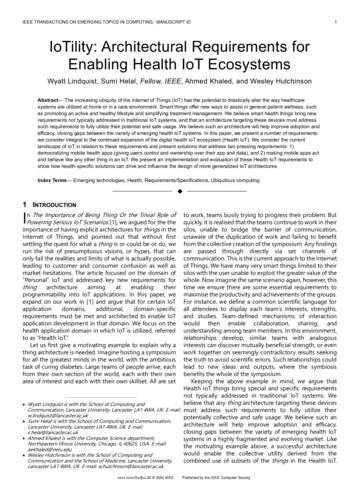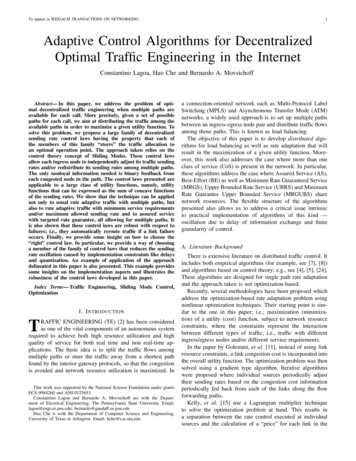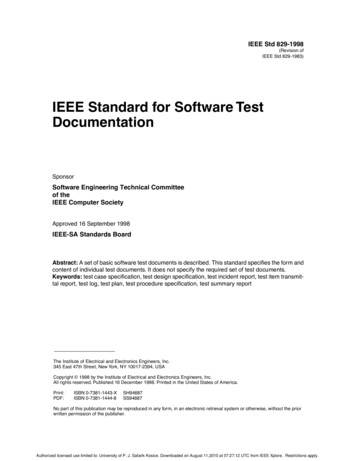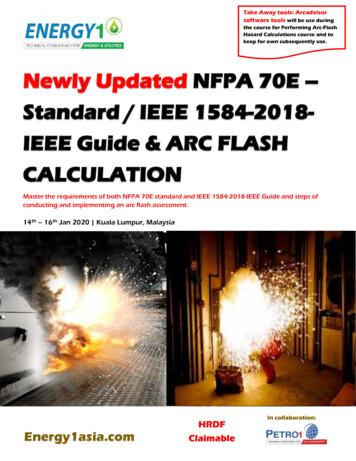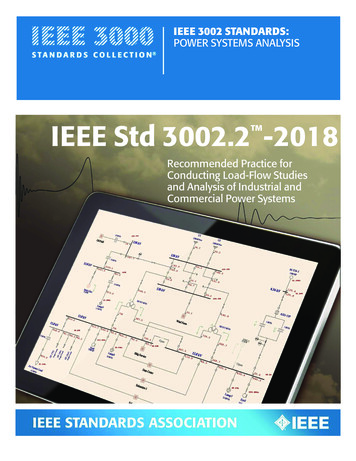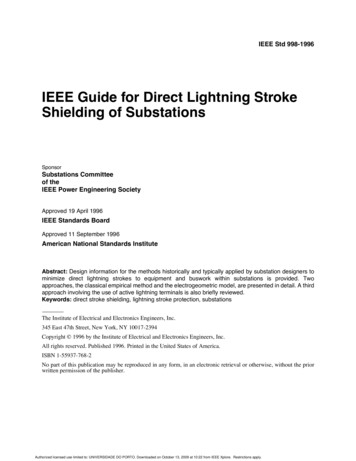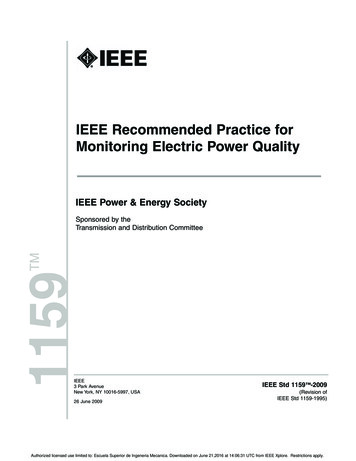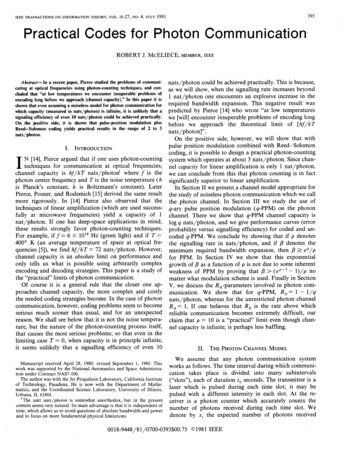
Transcription
IEEE TRANSACTIONSON INFORMATIONTHEORY,VOL.IT-27,NO.3934, JULY 1981Practical Codes for Photon Communication:ROBERT J. McELIECE, MEMBER,IEEEAbstract-In a recent paper, Pierce studied the problems of communicating at optical frequencies using photon-counting techniques, and concluded that “at low temperatures we encounter insuperable problems ofencoding long before we approach [channel capacity].” In this paper it isshown that even assuming a noiseless model for photon communication forwhich capacity (measured in nats/photon) is infinite, it is unlikely that asignaling efficiency of even 10 nats/photon could be achieved practically.On the ‘positive side, it is shown that pulse-position modulation plusReed-Solomoncoding yields practical results in the range of 2 to 3nats/photon.I.INTRODUCTIONIN [14], Pierce argued that if one uses photon-countingtechniques for communication at optical frequencies,channel capacity is hf/kT nats/photon’ where f is thephoton center frequency and T is the noise temperature (his Plan&s constant, k is Boltzmann’s constant). LaterPierce, Posner, and Rodemich [15] derived the same resultmore rigorously. In [14] Pierce also observed that thetechniques of linear amplification (which are used successfully at microwave frequencies) yield a capacity of 1nat/photon.If one has deep-space applications in mind,these results strongly favor photon-counting techniques.For example, if f 6 X lOI Hz (green light) and if T 400” K (an average temperature of space at optical frequencies [5]), we find hf/kT 72 nats/photon. However,channel capacity is an absolute limit on performance andonly tells us what is possible using arbitrarily complexencoding and decoding strategies. This paper is a study ofthe “practical” limits of photon communication.Of course it is a general rule that the closer one approaches channel capacity, the more complex and costlythe needed coding strategies become. In the case of photoncommunication, however, coding problems seem to becomeserious much sooner than usual, and for an unexpectedreason. We shall see below that it is not the noise temperature, but the nature of the photon-counting process itself,that causes the most serious problems; so that even in thelimiting case T 0, when capacity is in principle infinite,it seems unlikely that a signalling efficiency of even 10Manuscriptreceived April 28, 1980; revised September1, 1980. Thiswork was supported by the National Aeronauticsand Space Administration under Contract NAS7-100.The author was with the Jet Propulsion Laboratory,California Instituteof Technology,Pasadena.He is now with the Departmentof Mathematics, and the CoordinatedScience Laboratory,University of Illinois,Urbana, IL 61801.‘The unit nafs/photonis somewhat unorthodox,but in the presentcontext seems very natural. Its main advantage is that it is independentoftime, which allows us to avoid questions of absolute bandwidth and powerand to focus on more fundamentalphysical limitations.nats/photon could be achieved practically. This is because,as we will show, when the signalling rate increases beyond1 nat/photon one encounters an explosive increase in therequired bandwidth expansion. This negative result waspredicted by Pierce [14] who wrote “at low temperatureswe [will] encounter insuperable problems of encoding longbefore we approach the theoretical limit of [hf/kTnats/photon]“.On the positive side, however, we will show that withpulse position modulation combined with Reed- Solomoncoding, it is possible to design a practical photon-countingsystem which operates at about 3 nats/photon. Since channel capacity for linear amplification is only 1 nat/photon,we can conclude from this that photon counting is in factsignificantly superior to linear amplification.In Section II we present a channel model appropriate forthe study of noiseless photon communication which we callthe photon channel. In Section III we study the use ofq-ary pulse position modulation (q-PPM) on the photonchannel. There we show that q-PPM channel capacity islog q nats/photon, and we give performance curves (errorprobability versus signalling efficiency) for coded and uncoded q-PPM. We conclude by showing that if p denotesthe signalling rate in nats/photon,and if p denotes theminimum required bandwidth expansion, then p 1 ep/pfor PPM. In Section IV we show that this exponentialgrowth of /3 as a function of p is not due to some inherentweakness of PPM by proving that p (e”-’ - 1)/p nomatter what modulation scheme is used. Finally in SectionV, we discuss the &,-parameters involved in photon communication. We show that for q-PPM, R, 1 - l/qnats/photon, whereas for the unrestricted photon channelR, 1. If one believes that R, is the rate above whichreliable communication becomes extremely difficult, ourclaim that p 10 is a “practical” limit even though channel capacity is infinite, is perhaps less baffling.II.THE PHOTONCHANNELMODELWe assume that any photon communication systemworks as follows. The time interval during which communication takes place is divided into many subintervals(“slots”), each of duration t, seconds. The transmitter is alaser which is pulsed during each time slot; it may bepulsed with a different intensity in each slot. At the receiver is a photon counter which accurately counts thenumber of photons received during each time slot. Wedenote by xi the expected number of photons received00 18-9448/8 l/0700-0393 00.750 198 1 IEEE
394IEEE TRANSACTIONSduring the ith time slot; xi will be called the intensity of thei th pulse.It may be that “noise photons” are present in such asystem, but in many cases of practical interest, noise photons are extremely rare. (For example, in a careful analysisof a potentially practical system, Katz [6] estimated therate of arrival of noise photons to be around 10 -’ persecond.) In any event we shall make the assumption thatno noise photons exist.2 In this case, because of the Poissonnature of photon arrivals, the probability that exactly kphotons will be received during a slot in which the laserwas pulsed with intensity x is e -Xx k/k !.Thus we have a discrete memoryless channel with aninput alphabet equal to the set of nonnegative real numbers (the possible values for the intensities xi), and outputalphabet equal to the set of nonnegative integers (thepossible outputs of the photon counter). If a real number xis transmitted, the probability that the integer k will bereceived is given byp(klx) eeX .(2.1)We call the channel described by (2.1) the photon channel.A code for this channel is a set of vectors X, (Xi,,. . . x,,), i 1; . .) M, of length n. Each componentxjj is a nonnegative real number, and represents an intensity of the transmitting laser. Assuming that each component of a codeword requires one time slot for transmission,the rate of such a code isR log M/n nats/slot.3(2.2)On the other hand, each component xii represents anaverage number of (received) photons, and so the code’srate in nats/photon isp R/p nats/p hoton, wherep 2 xij /nM, photons/sloti i,j1(2.3)(average).(2.4)The reciprocal of the rate R in (2.2) is a measure of“bandwidth expansion”. If we are transmitting at a rate ofsay A nats/s, using a code of rate R nats/slot, it followsthat we require A/R slots/second. Thus the slot rate isequal to the nat rate multiplied by the factor l/R. We thusdefineR l/R n/log M slots/t-rat,(2.5)and call p the bandwidth expansion factor.In the following sections, we will make various information-theoretic calculations using this model. The readershould bear in mind that since our chief aim is to showwhat is not possible, more elaborate models incorporatingexternal noise sources could only strengthen our conclusions.‘A careful information-theoreticanalysis of the photonnoise photons are present is given in [ 151.‘Throughoutthe paper all logarithms are natural.channelwhenIII.ON INFORMATIONTHEORY,VOL. IT-27,NO.4, JULY 1981PULSE POSITION MODULATIONIn [ 141, Pierce suggested the use of pulse position modulation (PPM) for optical communication. In PPM, a fixedinteger q L 2 is selected, and the transmission interval isdivided into consecutive blocks of q slots each. In eachsuch block the laser is pulsed in exactly one of the q slots ata fixed intensity h. We regard each of these q patterns as aletter in the sender’s alphabet. For example with q 4, ifwe denote “no pulse” by 0 and “pulse” by 1, the letters are1000, 0100, 0010, 0001. There are, however, q 1 possibilities for the received letter, because of the possibility that nophotons may be received in a slot in which the laser waspulsed. This erasure symbol (e.g. 0000 if q 4), is by (2.1)received with probability PE e -‘. On the other hand, ifeach of the q letters is sent with probability q -‘, each willcarry log q nats of information, using an average of Aphotons, so the rate of this primitive signalling strategy isp (log q)/A nats/photon. Hence for uncoded PPM, therelation between the error probability PE and the rate p ispE q-U/P)(3.1)It follows from (3.1) that for any fixed p 0, and e 0,there exists a q such that the corresponding PPM systemhas rate exceeding p nats/photon and error probability lessthan e. This shows that the capacity of the photon channel(measured in nats/photon) is infinite; indeed, this is essentially the argument given by Pierce in [ 141.As a practical system, uncoded PPM leaves much to bedesired, however. In Fig. 1 we have plotted PE versus p forPPM and q 25, 2”, 220. With q 2” for example, wecan achieve PE 10 -’ and p 1.0, but only at the cost ofan enormous bandwidth expansion factor (cf. (2.5)) of/3 2”/20 log 2 75639. But we can do much better usingcoded PPM.In coded PPM, the idea is to regard the q letter transmission alphabet as the input alphabet of a discrete memoryless channel with q 1 output letters. The (q 1)st letter(symbolically 00000) is regarded as an erasure symbol; thusthe photon channel of Section II, combined with q-aryPPM becomes a q-ary erasure channel with erasure probability e -‘. The capacity of this channel, which is achievedby a uniform probability distribution on the input alphabet, is (1 - e -“) log q nats/letter.Since each letterrequires an average of X photons, the channel capacitymeasured in nats/photon isC(q, X) ’ -{-’logqnats/photon.(3.2)If q is fixed, the supremum of C(q, h) over A 0 occurs asA 0, and isC(q) log q nats/photon.What (3.3) says is that if q-PPM is used, then forerror probability the largest possible value of p (cf.in the limit of arbitrarily complex coding, isnats/photon.But what can be achieved practically? We havethat if q is a power of two, Reed-Solomon (RS)(3.3)small(2.3)),log qfoundcodes,
MCELIECE:PRACTICALCODES FOR nceNATS/PHOTONof uncodedFig. 2.PPM.which are extremely efficient at correcting erasures, givegood performance. An (n, k) Reed-Solomoncode withsymbol alphabet GF( q), and n q - 1, can correct anypattern of up to n - k erasures. Furthermore, when q is apower of two, very efficient encoding and decoding procedures exist; indeed Berlekamp [2] has described a hardwareimplementation of a q 256 RS decoder which operates at40 Mbits/s.If we use an (n, k) RS code for the present application,each of the qk codewords carries klog q nats of information, and each codeword requires n pulses. Thus if we aretransmitting p nats/photon,the average number of photons/pulse is, klong9photons/pulse.It follows that the erasure probabilitying q-ary erasure channel isc e-“ VP,(3.4)Performanceof Reed-Solomon75639 down to (32/log(32)) X (31/16) 18) at only amodest increase in receiver complexity.On the other hand, by extrapolation we can see fromFig. 2 that even using coded PPM, one needs a very large qto obtain say PE 10 -6 at p 5. More generally, if q-aryPPM is used, each of the q input letters carries at mostlog q nats of information, so the bandwidth expansion j3must be 2 q/log q. However, from (3.3), p log q, and sofor p 1, we must have(3.7)Thus if PPM is used, the bandwidth occupancy must growexponentially with p. In the next section we will see thatany communication strategy for the photon channel willencounter similar difficulties.for the correspondIV.(3.5)where R k/n is the rate of the RS code. Since the RScode can correct all patterns of up to n - k erasures, thedecoding error probability PE satisfiesANEGATIVEwhere c is given in (3.5). In Fig. 2 we have plotted thisbound on PE versus p for five typical RS codes. The curvelabelled q 16 is for a (15,s) RS code with q 16. Theothers are (31,16), q 32; (63,32), q 64; (127,64), q 128; and (255,128), q 256. (Recall that as codes for thephoton channel, the length is actually n 16%15 240 forthe q 16 code; n 31.32 992 for q 32; n 4032for q 64; n 16256 for q 128; and n 65280 forq 256.) Each of these codes is the best RS code of itslength, at least in the limit as p 0, and so no significantimprovement is possible merely by altering the code ratek/n.We see by comparing Figs. 1 and 2 that, for example, atPE 10 -’ coded PPM with q 32 works as well as uncoded PPM with q 2 *’. This represents an enormousin bandwidthexnansion (from 220/10g(220) RESULTIn the last section we saw that PPM forces an exponential increase in bandwidth expansion as a function of p. Wenow show that any reliable coded communication systemfor the photon channel must encounter similar difficulties,viz. :13’ “7reductioncoded PPM(4.1)l.To prove (4. l), we return to the photon channel model ofSection II, and consider the mutual information 1(X, K),where X is a nonnegative random variable and K is anonnegative integer-valued random variable related to Xby the conditional probabilities (2.1). We now defineC(p) sup{I(X;K):E(X) ,u}.(4.2)According to Shannon’s noisy-channel coding theorem (see[4, ch. 7]), C(p) represents the maximum possible rate (innats per slot) of a reliable commun
394 IEEE TRANSACTIONS ON INFORMATION THEORY, VOL. IT-27, NO. 4, JULY 1981 during the ith time slot; xi will be called the intensity of the i th pulse. It may be that “noise photons” are present in such a system, but in many cases of practical interest, noise pho- tons are extremely rare. (For example, in a careful analysis of a potentially practical system, Katz [6] estimated the rate of .


